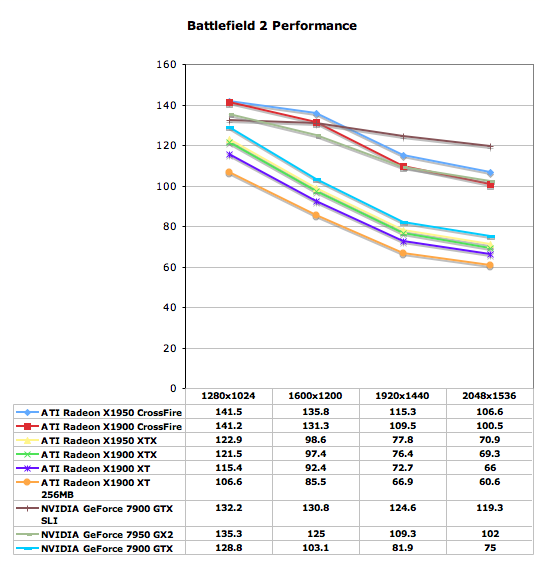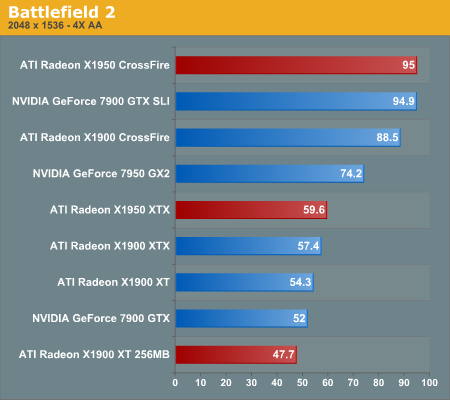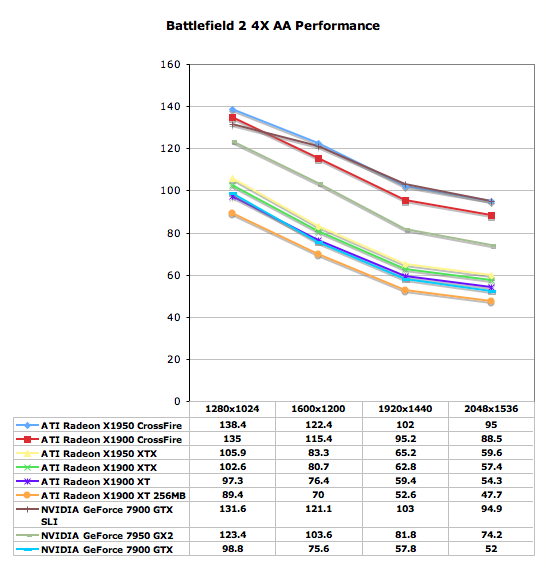ATI's New High End and Mid Range: Radeon X1950 XTX & X1900 XT 256MB
by Derek Wilson on August 23, 2006 9:52 AM EST- Posted in
- GPUs
Battlefield 2 Performance
This benchmark is performed using DICE's built in demo playback functionality with a few added extras built in house. When using the built in demo playback features of BF2, frames rendered during the loading screen are counted in the benchmark. In order to get a real idea of performance, we use the instantaneous frametime and frames per second data generated from a benchmark run. We discard the data collected during the loading screen and calculate a result that represents the actual gameplay that was benchmarked. While DICE maintains that results over 100fps aren't reliable, our methods have allowed us to get useful data from high performing systems.
During the benchmark, the camera switches between players and vehicles in order to capture the most action possible. There is a lot of smoke and explosions, so this is a very GPU intensive Battlefield 2 benchmark. The game itself is best experienced with average in-game framerates of 35 and up.
We ran Battlefield 2 using the highest quality graphics settings we could. Shadows, lighting, and especially view distance are very important in order to best play the game. In our opinion view distance should never be set to less than the max, but other settings can be decreased slightly if a little more performance or a higher resolution is required.

At the very top of the charts the GeForce 7900 GTX SLI manages to maintain just under a 12% advantage over the X1950 CrossFire, indicating to NVIDIA that it may not need to even respond with a new product to combat ATI's launch today at the high end. A single 7950 GX2 offers virtually identical performance to the X1950 CrossFire, showcasing the main strength of the 7950 GX2: its ability to offer dual card performance in a single slot in any platform. The performance advantage the X1950 CrossFire offers over its X1900 predecessor is 6%, definitely not enough to warrant an upgrade.
Single card performance is representative of what we've seen with multi-GPU performance, with the single 7900 GTX outperforming a single X1950 XTX. Note that the 7900 GTX's performance advantage actually grows from one to two cards, thanks to better scaling with NVIDIA's SLI architecture over ATI's CrossFire.
At the very bottom of the chart we've got the X1900 XT 256MB which really puts things into perspective. Being able to deliver 60 fps at 2048 x 1536 itself, most users will be monitor limited before they are GPU limited in games like Battlefield 2; in which case, the clear recommendation here is the $280 X1900 XT (or the similarly priced factory overclocked 7900 GT as we saw earlier in this review).

Although the 7900 GTX SLI performs better at higher resolutions, ATI's X1950 and X1900 CrossFire setups actually perform better at lower, more CPU bound resolutions, indicating greater driver overhead with NVIDIA's SLI. CPU limitations are quite evident at lower resolutions with the multi-GPU setups further reinforcing the idea that if you've got a LCD with a 1280 x 1024 maximum resolution, then you may want to think twice about upgrading to a second GPU.
The CPU limitations seen at 1280 x 1024 start to fade away as we move to 1600 x 1200, where the multi-GPU pack separates itself from the single GPU cards. What's interesting is that, with the exception of NVIDIA's 7900 GTX SLI, the remaining multi-GPU cards have similar resolution scaling curves to the single cards, just at higher frame rates.

When AA gets kicked on, we see the numbers get shaken up a bit. X1950 CrossFire essentially ties 7900 GTX SLI for the performance lead, and the 7950 GX2 drops to the bottom of the multi-GPU pile. Single GPU performance becomes dominated by ATI cards with the 7900 GTX falling to nearly the level of the 256MB X1900 XT. At the same time, it is a nice treat to realize that even the 256MB X1900 XT is playable at 2048x1536 with all the eye candy cranked up.

Our scaling graph doesn't show the same CPU limitedness we saw without AA enabled. The 7900 GTX SLI does see a hint of performance loss due to driver overhead here as well, but otherwise all these cards scale similarly as in the previous test.










74 Comments
View All Comments
Vigile - Wednesday, August 23, 2006 - link
My thought exactly on this one Anand...Anand Lal Shimpi - Wednesday, August 23, 2006 - link
You can run dual monitors with a CrossFire card as well, the CrossFire dongle that comes with the card has your 2nd DVI output on it :)Take care,
Anand
kneecap - Wednesday, August 23, 2006 - link
What about VIVO? The Crossfire Edition does not support that.JarredWalton - Wednesday, August 23, 2006 - link
For high-end video out, the DVI port is generally more useful anyway. It's also required if you want to hook up to a display using HDCP - I think that will work with a DVI-to-HDMI adapter, but maybe not? S-VIDEO and Composite out are basically becoming seldom used items in my experience, though the loss of component out is a bit more of a concern.JNo - Thursday, August 24, 2006 - link
So if I use DVI out and attach a DVI to HDMI adaptor before attaching to a projector or HDTV, will I get a properly encrypted signal to fully display future blu-ray/hd-dvd encrypted content?The loss of component is a bit of a concern as many HDTVs and projectors still produce amazing images with component and, in fact, I gather that some very high resolutions+refresh rates are possible on component but not DVI due to certain bandwidth limitations with DVI. But please correct me if I am wrong. I take Anandtech's point on the crossfire card offering more but with a couple of admittedly small quesiton marks, I see no reason not to get the standard card and crossfire for the second later if you decided to go that route...
JarredWalton - Thursday, August 24, 2006 - link
I suppose theoretically component could run higher resolutions than DVI, with dual-link being required for 2048x1536 and higher. Not sure what displays support such resolutions with component inputs, though. Even 1080p can run off of single-link DVI.I think the idea with CF cards over standard is that they will have a higher resale value if you want to get rid of them in the future, and they are also more versatile -- TV out capability being the one exception. There are going to be a lot of people that get systems with a standard X1950 card, so if they want to upgrade to CrossFire in the future they will need to buy the CrossFire edition. We all know that at some point ATI is no longer going to make any of the R5xx cards, so if people wait to upgrade to CrossFire they might be forced to look for used cards in a year or two.
Obviously, this whole scenario falls apart if street prices on CrossFire edition cards end up being higher than the regular cards. Given the supply/demand economics involved, that wouldn't be too surprising, but of course we won't know for another three or four weeks.
UNESC0 - Wednesday, August 23, 2006 - link
thanks for clearing that up Anand, news to me!TigerFlash - Wednesday, August 23, 2006 - link
I was wondering if anyone thinks it's wise to get an intel core duo 2 motherboard with crossfire support now that AMD is buying out ATI. Do you think ATI would stop supporting Intel motherboards?johnsonx - Wednesday, August 23, 2006 - link
Of course not. AMD/ATI isn't stupid. Even if their cross-licensing agreement with Intel didn't prevent them from blocking Crossfire on Intel boards (which it almost surely does), cutting out that part of the market would be foolish.
dderidex - Wednesday, August 23, 2006 - link
What's with the $99 -> $249 gap?Weren't we supposed to see an X1650XT, too? Based on RV570? ...or RV560? Something?